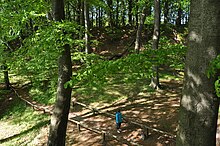Herthaburg
The Herthaburg near the stump chamber in the Jasmund National Park on the island of Rügen is a hill fort from the time of the Slavic settlement of Rügen from the 8th to the 12th century. The system was built on an existing ridge on the northeastern bank of Lake Herthas in the Stubnitz . The area enclosed by the wall and the shore of the lake is approx. 120 × 60 m and the width of the entire wall is over 180 m. From the outside, the wall in the north-eastern area is a maximum of 17 m high, but only 8 m from the inside. The upper edge of the wall is 136 m above sea level. NN . The open south side of the complex borders on the Herthasee, which at that time was probably also used to access the castle via a bridge; today's access to the interior of the castle came about later. To the northeast, the wall joins an earlier outer bailey, which can be clearly seen from the way to the Königsstuhl .
During excavations it was found that in the cultural layer from the Slavic period there is at least a stone pavement in places and through the archaeological analysis of ceramic shards found in this layer, the use of the castle could be dated to at least the 10th to 11th centuries .
Say
Like the adjacent Herthasee, the Herthaburg and its surroundings are linked with various legends .
There are many legends about Herthaburg, Herthasee and Herthabuche on Rügen. Hertha is said to have been a Germanic goddess who lived in the castle of the same name and bathed in the lake. The servants present at the bath were killed so that they could not reveal anything about the ceremony. Their spirits often still gather on the bank today. The lake was probably a place of worship for both the Germanic Rugians and the Wendish Rans. There is also a so-called sacrificial stone not far from the lake shore.
These were mostly created during the Romantic period at the end of the 18th century and in the first half of the 19th century. This was also the time when tourism slowly began to develop on Rügen. For example, the spa guests of the "fountain, bathing and amusement facility" in Sagard, which operated from 1795 to 1806, wanted to be entertained accordingly on their hikes through the forests of the Stubnitz. The operators of this first spa facility on Rügen, the brothers Heinrich Christoph and Moritz von Willich , had paths and bank stairs built in the previously almost undeveloped area and the innkeepers of the Gasthof am Königsstuhl, which was built in 1835, were also interested in additional " Attractions". The Sagenstein was arranged near the Herthaburg on the way to the Königsstuhl , a trough mill was placed on the neighboring so-called sacrificial stone as a "blood collecting bowl" and there was also a particularly large old beech tree along the way, the Herthabuche , whose dead trunk is still standing today a legend (see web links). The sacrificial stone was mentioned by Theodor Fontane in his novel Effi Briest .
- The legendary world around the Herthaburg
Herthasee and Herthaburg (in the forest), seen from the south
literature
- Alfred Haas : Stubbenkammer, Herthasee and Herthaburg in history and legend . Szczecin 1928.
- Ingrid Schmidt: Hune grave and sacrificial stone - soil monuments on the island of Rügen . Hinstorff Verlag, Rostock 2001, ISBN 3-356-00917-6 .
Web links
Coordinates: 54 ° 34 ′ 13 ″ N , 13 ° 38 ′ 56 ″ E








